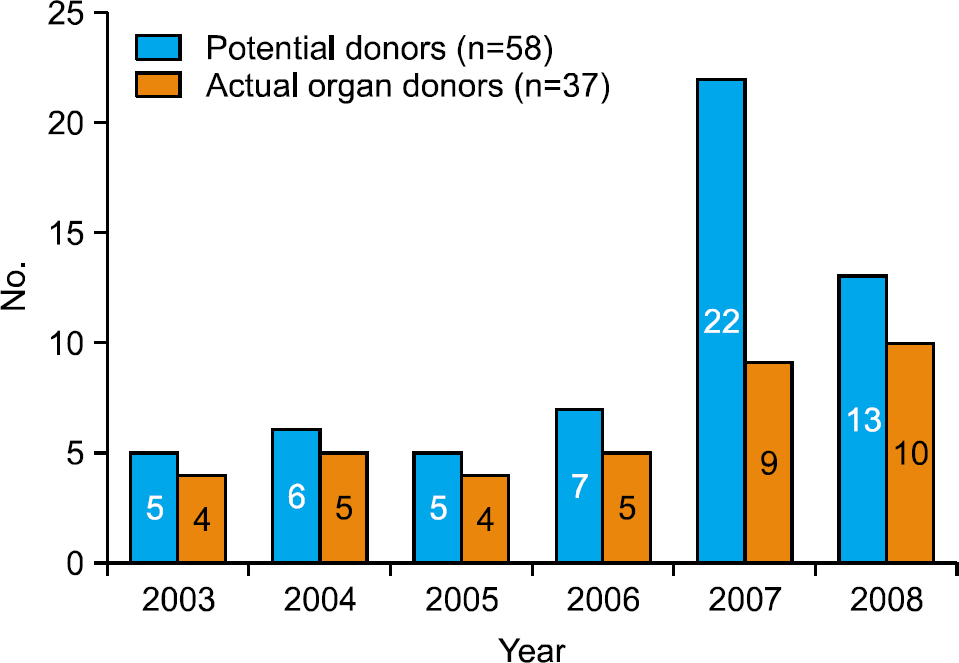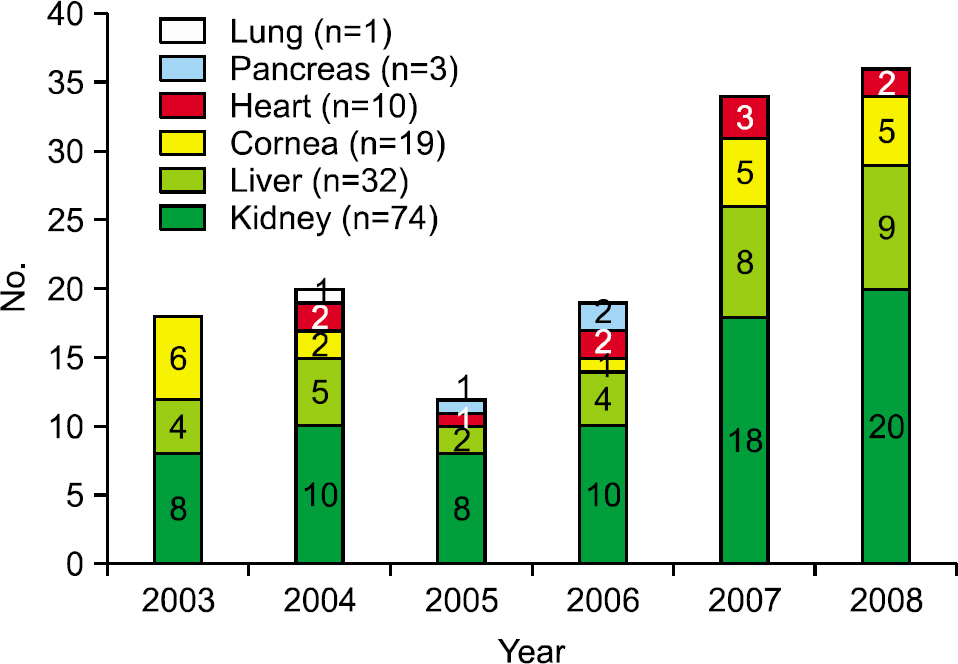The Organ Donation Rates in the Neurosurgical Field: Preliminary Study in a Single Institute
- Affiliations
-
- 1Department of Neurological Surgery, Ulsan University Hospital, University of Ulsan College of Medicine, Ulsan, Korea. parkjb@uuh.ulsan.kr
- 2Organ Transplantation Center, Ulsan University Hospital, University of Ulsan College of Medicine, Ulsan, Korea.
- KMID: 1819848
- DOI: http://doi.org/10.4285/jkstn.2009.23.3.252
Abstract
- BACKGROUND
In this study, we analyzed the brain death patients and the donation rates in our neurosurgical field and we discuss the factors that may be important for maximizing these rates by review of literatures.
METHODS
We performed a retrospective reviews of 3,016 patients who were admitted into the neurosurgical intensive care unit (NICU) from January 1, 2003 till December 31, 2008.
RESULTS
A total of 300 deaths in the NICU was recorded. The major cause of death was cerebral lesion (92%, n=276). Among these deaths, the cerebral lesion was caused by hemorrhage (59%, n=176) and trauma (33%, n=100). The number of the medically or clinically suitable organ donors was 58 cases (19% of all deaths). Organ donation was realized in 37 cases (64% of all the potential donors). Among the non-donation cases, 16 cases refused organ donation, corresponding to a refusal rate of 28%. Two cases were not suitable due to infection, one case was not suitable due to early death, and two cases were not suitable due to legal problems.
CONCLUSIONS
Despite that Koreans overwhelmingly support organ donation and transplantation, the actual donation rate remain low. The organ donation rate of our city as 10 PMP was higher than that of whole country last year. As a preliminary study, it will be necessary to analyze the difference of organ donation rate between our city and other cities to identify predictors to affect on donation.
MeSH Terms
Figure
Cited by 5 articles
-
Preliminary Results of Donor Action in Korea
Seok Ju Park, Young Chul Yoon, Won Hyun Cho, Leo Roels, Jacqueline Smits, Bernard Cohen, Nam Young Kim, Chun Hee Bok, Sun Woo Kang, Tae Hee Kim, Hyun Seung Lee, Yeong Hoon Kim
J Korean Soc Transplant. 2012;26(2):101-111. doi: 10.4285/jkstn.2012.26.2.101.Attitude Favorability towards Organ Donation in Family Members of Brain Dead Organ Donors
Jaeheon Lee, Jung Lee Won, Myeong Lee Jae
J Korean Soc Transplant. 2014;28(4):219-225. doi: 10.4285/jkstn.2014.28.4.219.Influencing Factors Affecting Successful Organ Donation and Families’ Consent to Donate after Drain Death
Eun Woo Lee, Hye Yeon Jang, Sang Youb Han, Kum Hyun Han, Se Won Oh, Young-Nam Roh
J Korean Soc Transplant. 2017;31(1):43-48. doi: 10.4285/jkstn.2017.31.1.43.Operational and Regulatory System Requirements for Pursuing Self-sufficiency in Deceased Donor Organ Transplantation Program in Korea
Myung-Gyu Kim, Cheol Jeong Jong, Eun Jin Cho, Ha Huh Kyu, Jaeseok Yang, Im Byeon Nyeon, Sook Yu Jin, Tae Bang Ki, Heoung Soo Chung, Won Ha Jong, Il Kim Soon, Hyun Cho Won, Curie Ahn
J Korean Soc Transplant. 2010;24(3):147-158. doi: 10.4285/jkstn.2010.24.3.147.Clinical Analysis of 10 Years Brain Death Donors in Single Center after Korean Network for Organ Sharing
Jae-myeong Lee, Young-Joo Lee, Kyu-Dong Kyung, Yong-Cheol Im, Chang-Kwon Oh, Jung-Hwan Ahn, Young-Gi Min, Ji-Hye Kim, Mi-Young Lee
J Korean Soc Transplant. 2010;24(3):196-203. doi: 10.4285/jkstn.2010.24.3.196.
Reference
-
1). Korean Network for Organ Sharing (KONOS). Statistics of organ transplantation [Internet]. Seoul: KONOS;2009. Available from. http://www.konos.go.kr.2). The Ad Hoc Committee of the Harvard Medical School to Examine the Definition of Brain Death. A definition of irreversible coma. JAMA. 1968; 205:337–40.3). The Quality Standards Subcommittee of the American Academy of Neurology. Practice parameters for de-termining brain death in adults (summary statement). Neurology. 1995; 45:1012–4.4). Teja JL, Quesada A, Rabanal JM, Fleitas MG, Cotorruelo JG, Espadas FL. Organ donor management: review of 68 consecutive cases. Transplant Proc. 1991; 23:2490.5). Broznick BA. Organ procurement: fulfilling a need. Transplant Proc. 1988; 20(S1):1010.6). Evans RW. The actual and potential supply of organ donors in the United States. Clin Transpl. 1990; 329–41.7). Bart KJ, Macon EJ, Humphries AL Jr, Baldwin RJ, Fitch T, Pope RS, et al. Increasing the supply of cadaveric kidneys for transplantation. Transplantation. 1981; 31:383–7.
Article8). Stuart FP. Need, supply, and legal issues related to organ transplantation in the United States. Transplant Proc. 1984; 16:87–94.9). Organ Procurement and Transplantation Network (OPTN). Deceased Donors recovered in the U.S. by Donation Service Area [Internet]. U.S.: U.S. Department of Health & Human Services 2009. Available from. http://optn.transplant.hrsa.gov/latestData/rptData.asp.10). Sanz A, Boni RC, Ghirardini A, Costa AN, Manyalich M. IRODaT 2006. International donation and transplantation activity. Organs and Tissues and cells. 2007; 77–80. Available from. http://www.etco.org/uploads/pdfs/Irodat/IRODAT07-02.pdf.11). Koran Statistical information Service (KOSIS). Total number of population [Interne]. Korea: KOSIS;2009. Available from. http://www.kosis.kr/.12). Gortmaker SL, Beasley CL, Brigham LE, Franz HG, Garrison RN, Lucas BA, et al. Organ donor potential and performance: size and nature of the organ donor shortfall. Crit Care Med. 1996; 24:432–9.13). Jacobs DG, Brandt CP, Piotrowski JJ, McHenry CR. Transcranial gunshot wounds: cost and consequences. Am Surg. 1995; 61:647–53.14). Kennedy F, Gonzalez P, Dang C, Fleming A, Sterling- Scott R. The Glasgow Coma Scale and prognosis in gunshot wounds to the brain. J Trauma. 1993; 35:75–7.
Article15). Shackford SR, Mackersie RC, Davis JW, Wolf PL, Hoyt DB. Epidemiology and pathology of traumatic deaths occurring at a Level I Trauma Center in a re-gionalized system: the importance of secondary brain injury. J Trauma. 1989; 29:1392–7.16). Madsen M, BØgh L. Estimating the organ donor potential in Denmark: a prospective analysis of deaths in intensive care units in northern Denmark. Transplant Proc. 2005; 37:3258–9.
Article17). Grundmann R, Kammerer B, Franke E, Pichlmaier H. Effect of hypotension on the results of kidney storage and the use of dopamine under these conditions. Transplantation. 1981; 32:184–7.
Article18). Mackersie RC, Bronsther OL, Shackford SR. Organ procurement in patients with fatal head injuries. The fate of the potential donor. Ann Surg. 1991; 213:143–50.
Article19). Nygaard CE, Townsend RN, Diamond DL. Organ donor management and organ outcome: a 6-year review from a Level I trauma center. J Trauma. 1990; 30:728–32.20). Lucas BA, Vaughn WK, Spees EK, Sanfilippo F. Identi-fication of donor factors predisposing to high discard rates of cadaver kidneys and increased graft loss within one year posttransplantation - SEOPF 1977-1982. South-Eastern Organ Procurement Foundation. Transplantation. 1987; 43:253–8.
- Full Text Links
- Actions
-
Cited
- CITED
-
- Close
- Share
- Similar articles
-
- Factors Influencing Family's Organ Donation Decision
- Meaningful Correlation between the donor registration rate and the number of organ donors by region
- Attitude Favorability towards Organ Donation in Family Members of Brain Dead Organ Donors
- Willingness and attitude of the Arab world population towards solid organ
- National Organ Transplantation Policy






